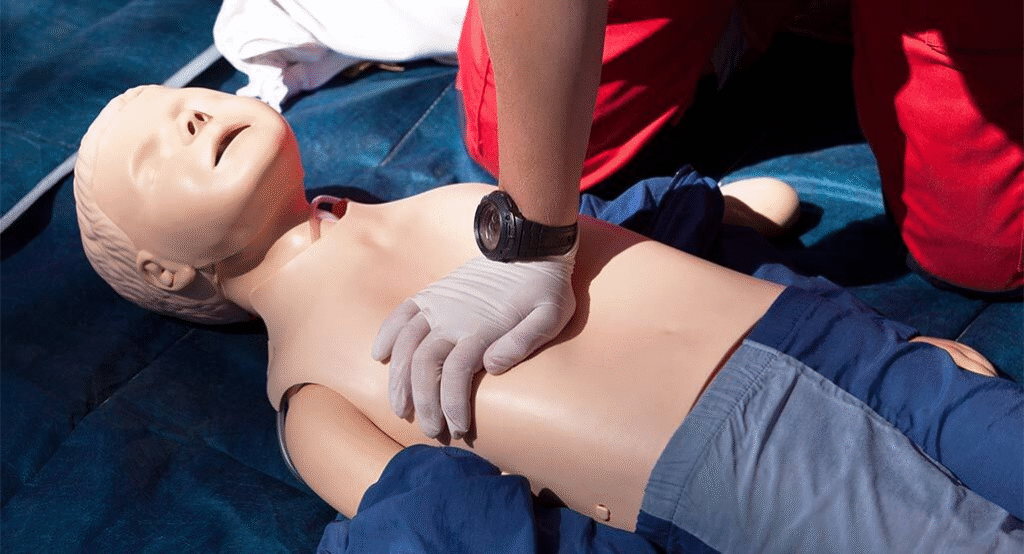This step-by-step guide offers essential first aid for choking and CPR, with visual aids from BabyCenter Courses’ infant first aid and CPR class.

Be Ready for the Unexpected
Prepare for emergencies with advice from an ER doctor in our CPR and Choking Course.
Taking an infant and child CPR course is crucial to understanding the proper techniques, which vary based on the child’s age. Using the wrong method could cause harm. Check below for where to find a course.
These instructions focus on babies under 12 months old. If you need guidance on what to do for older children, refer to our CPR guide for those 12 months and older.
Key Points to Remember
- Assess the situation: Quickly understand the emergency, and act fast.
- Choking: If the baby is choking but still conscious, help them dislodge the object. If they become unresponsive, perform CPR.
- First Aid: If you’re alone, perform first aid for 2 minutes before calling 911. If others are present, have someone call 911 while you assist the baby.
- Take an In-Person Class: Parents and caregivers should consider taking a class to learn infant-specific techniques.
What to Do if Your Baby is Choking
Step 1: Assess the Situation
If your baby can’t cry or cough, something is likely blocking their airway. They may open their mouth without sound, and their skin could turn red or blue.
If they’re coughing or gagging, their airway is partially blocked. Let them cough; it’s the most effective way to clear the blockage.
Call 911 if:
- The baby can’t cough up the object.
- You suspect swelling due to an allergic reaction (like food or insect bites) or illness (such as croup).
- You saw the baby suddenly collapse.
Step 2: Try Back Blows and Chest Thrusts
Back Blows:
If the baby is conscious but can’t cough or cry, hold them face-up on your forearm, supporting their head. Turn them over, so their head is lower than their chest, and deliver five firm back blows between the shoulder blades to try and dislodge the object.
If the object doesn’t come out, flip the baby onto their back, supporting their head and neck, and proceed with chest thrusts.
Chest Thrusts:
Position your fingers on the baby’s chest just below the nipple line. Push down firmly about 1 ½ inches. Perform five chest thrusts.
Alternate between back blows and chest thrusts until the object comes out, or the baby starts coughing, crying, breathing, or becomes unresponsive.
If the baby becomes unresponsive, perform CPR (see below).
CPR for Babies
CPR is a lifesaving technique for infants who are unresponsive and not breathing. It helps circulate oxygenated blood to vital organs.
Step 1: Verify the Baby’s Condition
Call the baby’s name. If they don’t respond, check for breathing by watching their chest or listening for breaths.
If the baby isn’t breathing or is gasping, call 911 or have someone else do so. If you’re alone, provide two minutes of care, then call 911.
Step 2: Perform 30 Chest Compressions
Place two fingers in the center of the baby’s chest, just below the nipple line. Push down about 1 ½ inches and let the chest rise after each compression. Aim for 30 compressions at a rate of about 2 per second.
Step 3: Give Two Rescue Breaths
Tilt the baby’s head back gently and seal their nose and mouth with your own. Give two gentle rescue breaths, watching for the chest to rise. If the chest doesn’t rise, reposition the head and try again.
If the airway is blocked, check the mouth for a visible object and remove it if you can.
Continue CPR (30 compressions and 2 breaths) until:
- You see signs of life.
- An AED is available.
- You need to call 911 after 2 minutes of care.
- EMS arrives.
- You’re too exhausted to continue.
Even if the baby seems fine when help arrives, a medical professional should assess them for any hidden injuries or airway issues.
Where to Take an Infant CPR and First Aid Class
The best way to learn CPR is through a class with a certified instructor. Hospitals, community centers, and organizations like the American Red Cross offer classes.
Tips:
- “Every time I have a baby, I attend CPR classes again for a refresher,” says one parent. It’s great for staying prepared.
- In-person classes are ideal, but online courses and video tutorials can also be useful.
For more information on CPR classes, visit the Red Cross website or call (800) 733-2767.
In a CPR class, you’ll learn:
- How to handle emergencies like choking or non-breathing.
- Accident prevention and childproofing techniques.
- How to use an AED (automated external defibrillator).
- How to care for burns, wounds, and sudden illnesses in children.
Courses typically last 2 to 5 hours.
While taking a CPR class in person is recommended, BabyCenter Courses and the American Heart Association offer alternative self-paced options for learning CPR at home.
Being prepared and knowing how to act quickly in an emergency could save a life. Take a class today to ensure you have the skills and confidence to respond effectively if needed.